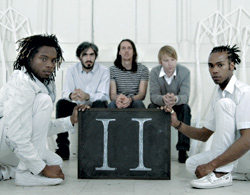Serial killers’ efforts to conceal their identities usually begin to crumble once they start contacting the media or the authorities, either with cryptic messages or “calling cards” left at crime scenes; psychologists say it comes from the subconscious desire to be caught or an ego-driven compulsion to show the world exactly who they are.
There are no serial killers in Lansing-Dreiden. Or perhaps there are? Nobody knows for sure, because to this point the true identities of the New York–based multimedia outfit’s members have been shrouded in secrecy. They offer no photos and very rarely grant interviews; when they do, it’s only via e-mail, and the responses are typically ambiguous. The group states its mission on its Web site thusly: “Lansing-Dreiden is a company that sees no distinction between art and commerce—or anything else. Hence, the output of the organization may manifest itself in various forms, from video to music to product design to the construction of narratives.”
Indeed, since 2000 L-D have been responsible for numerous art gallery installations (illustrations, videos, sculptures, and more, most of it sticking to a sleek, minimalist design aesthetic that favors black-and-white and geometric shapes); several issues of a literary magazine called Death Notice; and three albums—full-length debut The Incomplete Triangle and four-song EP A Sectioned Beam (both released in 2004) and the new The Dividing Island—none of which includes individuals’ names in the liner notes. The members of Lansing-Dreiden refuse to appear at any exhibits, frequently sending “ambassadors” to represent “the company.” Nor will they play live; instead, they commission outside musicians to perform their material in select cities—last year’s L-D Section I touring ensemble, for example, featured nine players, including members of Mice Parade and Diamond Nights.
Given this carefully constructed, Skull & Bones–like enigma, it came as quite a surprise to learn that one Bruce Borders—who is playing guitar and bass in the current five-member L-D Section II lineup—had agreed to let me interview him by phone. Were Lansing-Dreiden hungering for the world to know more about them? Would this emissary, intentionally or not, help unravel the group’s well-guarded secrets?
Well, not really. Under questioning, Borders remained tight-lipped as to his employers’ identities, saying only that there are three core members of Lansing-Dreiden responsible for writing and recording the albums and creating all of the artwork. Borders also attempted to downplay the whole conundrum. “I don’t think they ever really wanted it to be mysterious, necessarily,” he claimed. “It’s just that they’re more interested in the focus being entirely on the art and the music than them as personalities.”
The task of L-D Section II—which also includes Jay Is on keyboards and guitar, Kris King on drums, and singers Sect and Ion (who were discovered via an ad placed on Craigslist)—is to re-create The Dividing Island‘s sophisticated, densely layered compositions, on which Lansing-Dreiden deliver languid dream-pop and space-rock that recall the trippier moments of the Verve and Ride, and exceedingly suave, highly manicured synth-pop that could’ve come from the brains of Roxy Music, Spandau Ballet, or ABC. The quintet is also configured to maintain Lansing-Dreiden’s visual aesthetic onstage; Sect and Ion, both African American, typically don white outfits, while the three backing musicians, who are white, usually wear black.
“I think it’s really interesting for [Lansing-Dreiden] to be able to totally reinvent the band every time something new they’re working on comes out, and still have it be thematically linked,” Borders explained. “I mean, you have groups like the White Stripes that have this real visual thing that they set up, and that’s cool, but most of the time you look through the magazines and it’s four greasy-haired dudes standing up against a brick wall or something. The music could be totally cool, but the presentation is just kinda boring, and these guys don’t want that sorta thing to represent Lansing-Dreiden.”
As surrogates for the real Lansing-Dreiden, Borders said L-D Section II are learning how to deal with inquiries about identities from both fans and nosy journalists. “It’s not really about withholding information; it’s just like when people wanna know personal stuff, we just can’t get into it,” he insisted. “We answer as much as we can, but we’re not really the creators of the entire thing, so it’s hard for us to give all the answers.”
With that, the conversation came to a close. And yet, after I hung up the phone, I couldn’t help but feel a bit like Chazz Palminteri at the end of The Usual Suspects, when he realizes he’s just let the murderous Keyzer Soze slip from his grasp. Was “Bruce Borders” really just a proxy for Lansing-Dreiden, or one of its actual members, or perhaps even its mastermind? The mystery continues. . . .








